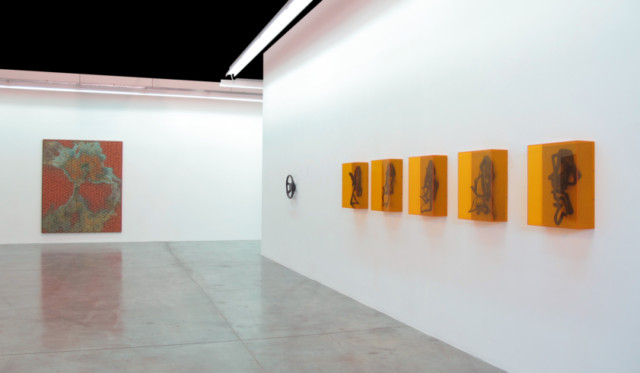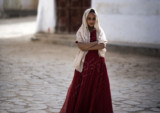
Michael Sailstorfer’s first solo exhibition in Dubai, “Try to reach the goal without touching the walls”, features a series of oxidation paintings depicting his attempts to find his way through various mazes. The young German artist is also displaying a set of artworks inspired by Formula One race tracks and a video featuring a car journey. The mazes and the racetracks are a metaphor for life, and the artworks are essentially about navigating the twists and turns in life, making the right decision at every turn and steering oneself in the correct direction.
“Life and art are always about making decisions. When I started working with mazes a few years ago, I was at a point in my career where I was questioning myself about what would be the right direction to take in my art and where I wanted to go. To create a visual representation of what was going on in my mind, I decided to use the technique of oxidation painting. I coated my canvases with metallic primers containing iron or copper. On these metallic surfaces I printed various mazes that I found on the internet, ranging from circular and square ones to abstract shapes and figurative ones such as a maze in the shape of Iron Man. I then tried to follow the standard instruction that comes with these mazes of ‘reaching the goal without touching the walls’. But rather than using paint to trace my path, I navigated the maze with an acid spray. The streaks of metallic reds, browns and greens you see on the canvases are caused by the oxidation of the metal primers by the acid,” Sailstorfer says.
The artist readily admits that the idea is inspired by Andy Warhol’s oxidation paintings. And just as the famous American artist used his urine as an acid to leave his personal trace on his paintings, Sailstorfer has deliberately left his footprints on many of the paintings as a mark of his presence.
The collages made from strips of rubber tyres are also labyrinths in the shape of race tracks, including the Formula One track in Abu Dhabi. And a steering wheel, cast in aluminium, installed on the wall, further underlines the idea of moving in the right direction in the journey of life.
Sailstorfer is also displaying for the first time a video he created in 2003 while he was still an art school student. The video shows him driving his car through the Bavarian landscape, singing along with the radio, with the lights in the car blinking like disco lights. The inclusion of this work in the show is a reference to his artistic journey from the beginning of his career to the present. His enjoying the drive in the video and the intuitive way he has sprayed the acid in his recent paintings offer insights into the artist’s attitude towards life and the process by which he makes his own decisions.
Jyoti Kalsi is an arts enthusiast based in Dubai.
The exhibition will run at Carbon 12, Al Quoz, until January 7, 2014.
BOX:
Art at the Courtyard
By Jyoti Kalsi
The ongoing exhibitions at the galleries located in the Courtyard in Al Quoz reflect the diversity of Dubai’s art scene. Total Arts is hosting “Journey to Yemen”, a series of photographs of Yemen as seen through the eyes of acclaimed artists. The exhibition is the result of a trip organised in 2009 by the gallery in collaboration with Arabia Felix and with support from Yemenia Universal Touring Company, the Yemen Tourism Department and Trucolour, Dubai. Participating artists included photographers based in Dubai and abroad such as Samar Jodha, Kamran Jebreili, Jason Larkin, Katarina Premfors, Manuel Salazar, Simone Santi, Suhail Semaan, Dariush Zandi and filmmaker Nader Bagherpour. They were joined by Yemeni photographers Asiya Al Sharabi and Abdul Rahman Hassan Jaber in Sana’a.
Their photographs range from images of the beautiful landscape and the ancient mud skyscrapers to intimate portraits of the people. “Yemen is a country that has a history going back more than 7,000 years and it has maintained its distinct character by preserving the old way of life, the Bedouin traditions and the centuries-old architecture — making it a living museum. Being there was an amazing experience for all of us and we have tried to capture various aspects of this country, its culture and its changing environment,” Zandi says.
Next door at Khak Gallery, well-known Iranian artist Fereydoun Ave is exhibiting his latest series of mixed-media works on paper titled “Persian Spring”. The soft, subtle artworks feature withered flowers and bits of smudged newspapers as sad reminders of past celebrations, forgotten words and the beauty around us that we do not notice any more. The artworks reference the Iranian New Year celebrations in spring, indicating a desire for new beginnings, both personally and perhaps politically.
Ave is also the curator of “Paper Works: 10 artists” at Etemad gallery, which has recently relocated to the Courtyard. The show features works on paper by ten Iranian artists, including Ave, Mohsen Ahmadvand, Raana Farnoud, Ali Golestaneh, Shahla Hosseini Barzi, Mohammad Hamzeh, Farshid Mesghali, Bijan Saffari, Vahid Sharifian and Ramtin Zad. The works on display range from dreamy watercolours by Saffari to Meshgali’s quirky papier-mâché figures. “For this show I have selected artists who, like me, work predominantly on paper. They have all trained with noted artist and teacher Bijan Saffari, whose students include modern Iranian masters belonging to different generations,” Ave says.
“Women in Art IX” at Courtyard Gallery is also a group exhibition featuring the work of 16 Dubai-based women artists. Organised in collaboration with Art Connection, the show is the ninth edition of an annual event that celebrates female creativity. The artworks on display include photography, acrylic, oil, charcoal and mixed-media paintings as well as handmade jewellery.
The exhibitions will run until January 14, 2014.












